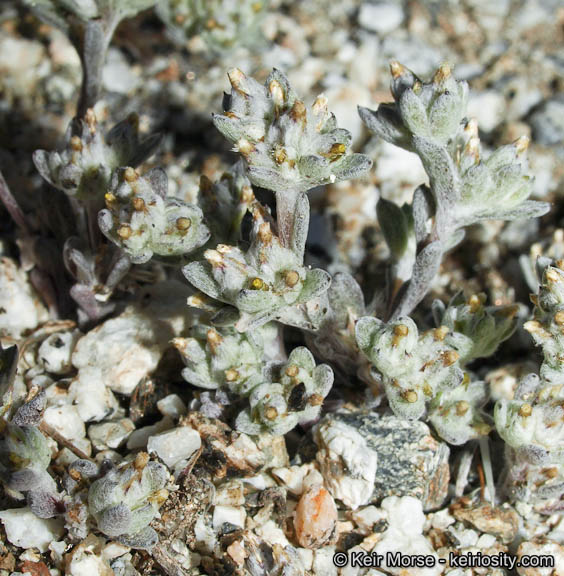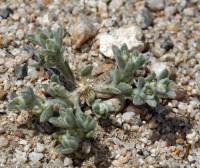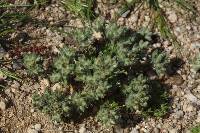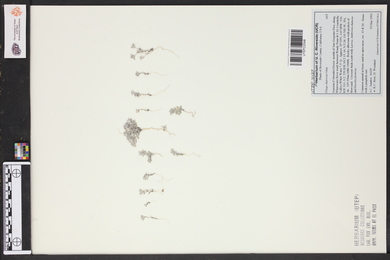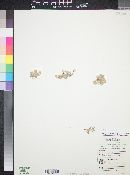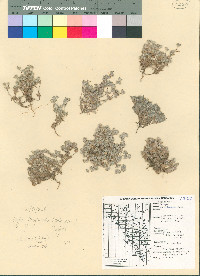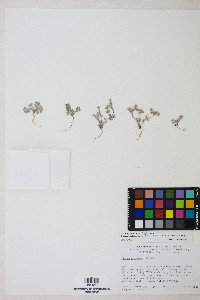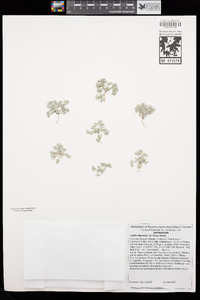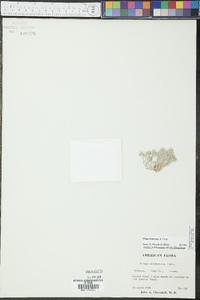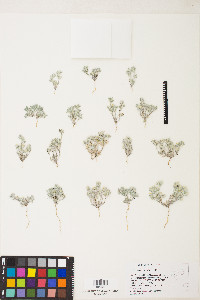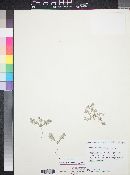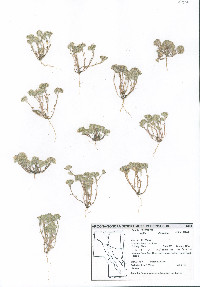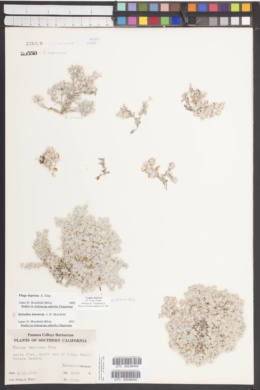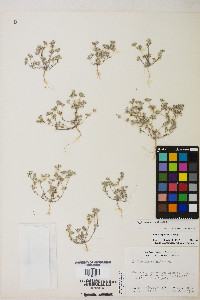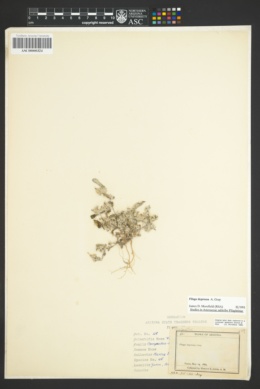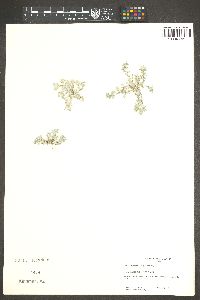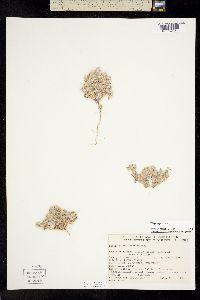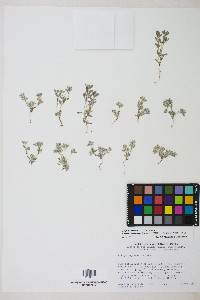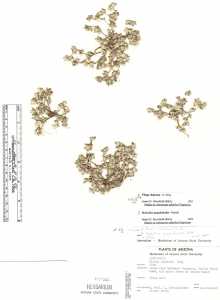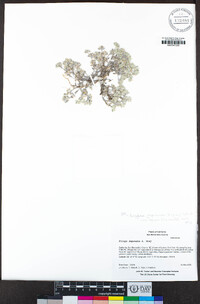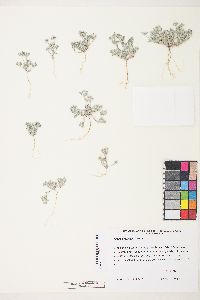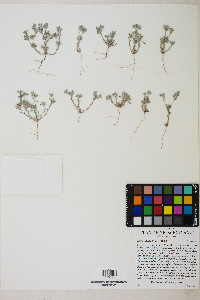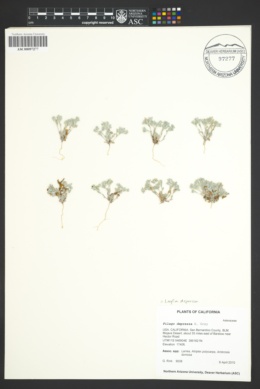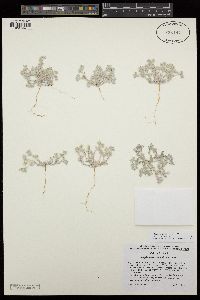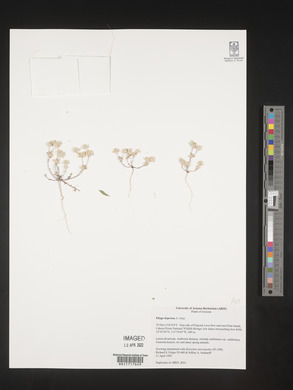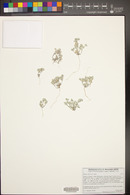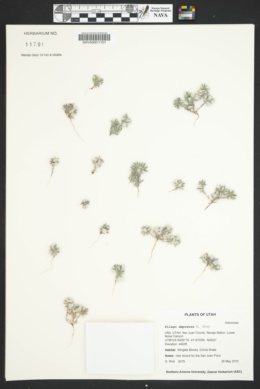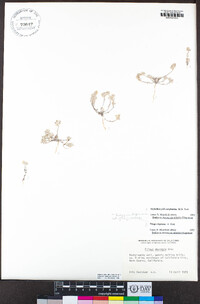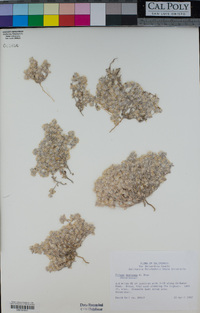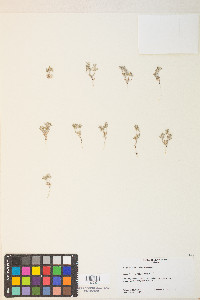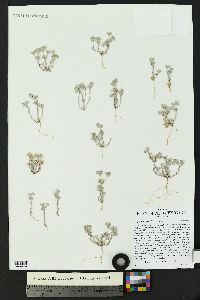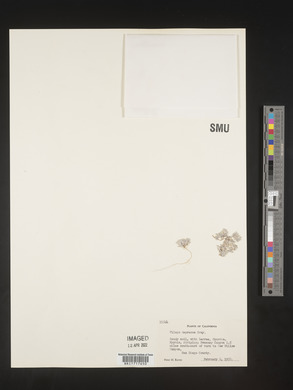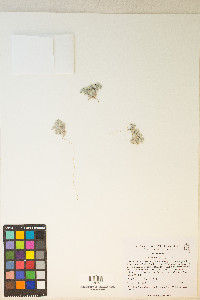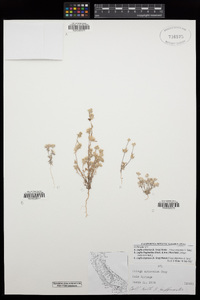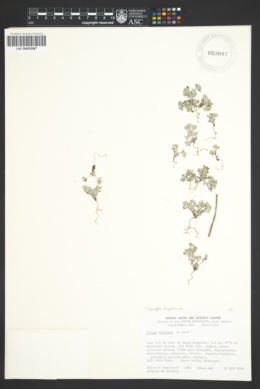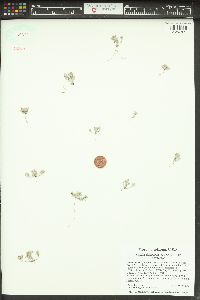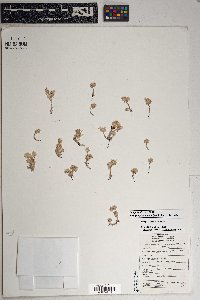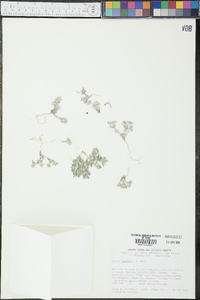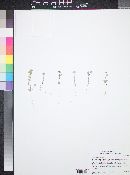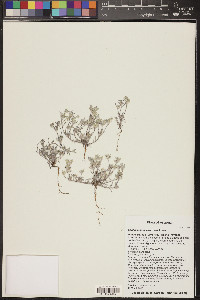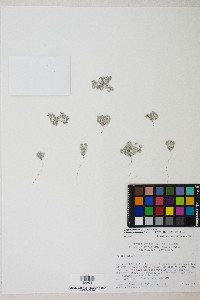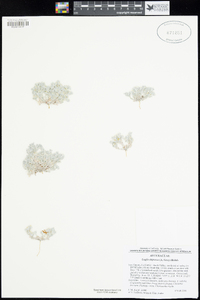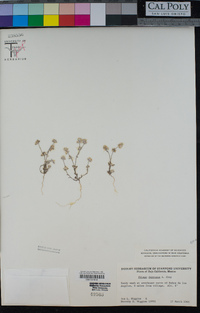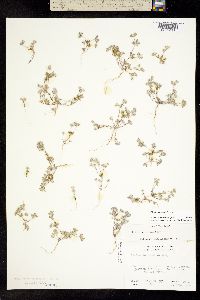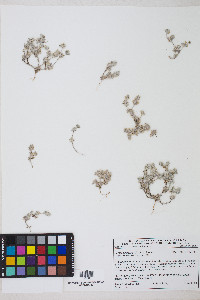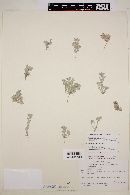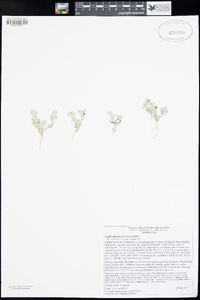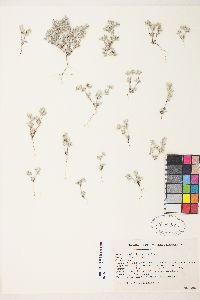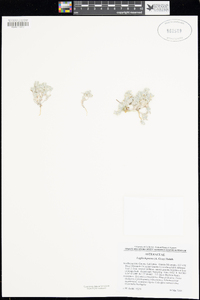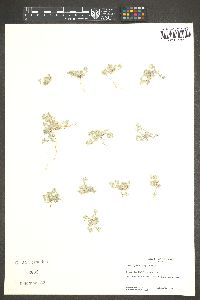Logfia depressa
|
|
|
|
Family: Asteraceae
Dwarf False Cotton-Rose, more...dwarf filago, dwarf cottonrose
[Filago depressa A. Gray] |
Plants 1-5(-10) cm. Stems (1-)3-10+, typically ± prostrate; branches ± leafy between proximal forks, remaining grayish to whitish, lanuginose. Leaves elliptic to obovate, largest 6-8(-10) × 1-2 mm, pliant; longest capitular leaves mostly 0.8-1.5 times head heights, obtuse. Heads in glomerules of 2-5 in ± dichasiiform arrays, ± pyriform, largest 3-4 × 2-2.5 mm. Phyllaries 0, vestigial, or 1-4, unequal, ± like paleae. Receptacles obovoid, 0.9-1.2 mm, heights 1.4-1.6 times diams. Pistillate paleae (except innermost) 7-13 in 2(-3) series, spirally ranked, loosely saccate, incurved 20-60°, somewhat gibbous, not galeate, longest 2.1-3.1 mm, distal 20-50% of lengths glabrous abaxially; bodies (except midnerves) chartaceous, ± terete; wings prominent. Innermost paleae ± 5, spreading in 1 series, pistillate. Pistillate florets: outer 7-13 epappose, inner (4-)10-21 pappose. Bisexual florets 2-5; corollas 1.3-2 mm, lobes mostly 5, yellowish to brownish. Cypselae: outer nearly straight, ± erect, compressed, 0.7-0.9 mm; inner mostly smooth; pappi of (11-)13-15 bristles falling in 1s or 2s, 1.3-2.4 mm. Flowering and fruiting mostly Feb-May. Desert flats, alluvial slopes, loose sandy to gravelly soils, openings among shrubs, often with extra moisture (dry drainages, roadsides), rarely outside deserts; 0-1500 m; Ariz., Calif., Nev.; Mexico (Baja California, Sonora). Reported to be eaten by desert tortoises (Gopherus agassizii), Logfia depressa is known from the Mojave Desert and most of the Sonoran Desert (except islands and lower Colorado River valley) including arid Baja California; isolated collections are known from southwestern California and Carson City, Nevada (where recently extirpated).
FNA 2006, Jepson 2012, Kearney and Peebles 1969 Duration: Annual Nativity: Native Lifeform: Forb/Herb General: Herbaceous annuals, to 70 cm tall, stems 1-10 or more, diffuse to ascending, branches usually leafless between proximal forks but becoming leafy, purplish to black,and glabrescent distally, herbage grayish to whitish with soft, short hairs (lanuginose). Leaves: Alternate, sessile or on very short petioles, elliptic to obovate, 6-10 mm long and 1-2 mm wide, blades flexible, with obtuse tips, distal leaves subtending heads, crowded. Flowers: Greenish with tan tips, densely covered with white, wooly hairs, clustered in groups of 2-5 in small, disciform, pear-shaped heads with pistillate and bisexual florets; outer pistillate florets 7-17 (pappus absent), bodies cartilaginous, obcompressed, curved inward 20-60 degrees, inner florets 4-21, (with pappus), innermost paleae around 5, spreading in 1 series, bisexual and usually pistillate; bisexual florets 4-10, with corollas 1-2 mm long, receptacles obovoid, 0.5-1 mm long, phyllaries absent or 1-4, unequal, heads sessile or with very short peduncles, subtended by leafy bracts, inflorescences solitary or more commonly in small, pyrimidal glomerules of 2-14, largest of these 3-4 mm long and 2-2.5 mm wide, usually borne at branch tips or sometimes between stem forks and tips. Fruits: Cypselae (achenes), outer incurved, proximally ascending, distally erect, obcompressed, to 1 mm long, surfaces smooth. Pappi absent or when present 11-15, 1-2.5 mm long, falling in 1s or 2s. Ecology: Found in dry, open areas, seasonally moist clay flats and sandy drainages, on slopes, coastal slopes, flood plains, rocky places, and roadsides, in Mediterranean to arid climates, from 0-4,500 ft (0-1372 m); flowering February-June. Distribution: Arizona, California, Nevada; Mexico. Notes: The disciform head is a special derivative of the radiate type which resembles the discoid head in lacking the marginal rays but the outer flowers are pistillate, with a tubular, rayless corolla. This small annual has greenish-white, wooly or cobwebby heads with tan tips, borne in pyrimidal inflorescences with leafy subtending bracts. The keys to this species are the diffuse or ascending leafy stems, the smooth achenes, and the outer bracts with a hayline appendage about as long as the body (if appendage is only about half as long as the body, see Logfia californica). Jepson 2012 reports some unverified specimens show this species occurring as high as 1600 m, (approx. 5,500 ft). Ethnobotany: Unknown Etymology: Logfia is apparently an anagram of the genus Filago. The genus is undergoing some revision, and the names Logfia and Oglifa, both anagrams, are in the running to take part of the original genus, and depressa means appearing to be pressed down flat. Synonyms: Filago depressa, Oglifa depressa Editor: LCrumbacher2012 Plant: Annual, grayish, cobwebby to tomentose; stems generally several from base, ± spreading, forked, < 11 cm, grayish to whitish, tomentose; central axis not dominant Leaves: < 11 mm, simple, elliptic to obovate, obtuse, rarely acute, flexible, grayish to whitish, tomentose; uppermost ± equaling heads INFLORESCENCE: primary inflorescence a head, each resembling a flower; heads disciform, in loose, ± hemispheric groups of 2-5, not restricted to forks and tips of branches; longest 3-4 mm, ± 2-2.5 mm wide, grayish to whitish, largest groups 5-9 mm diam; chaff scales in spiral ranks, longest 2.1-3.1 mm, body (except central vein) of outer scales soft, membranous Flowers: Pistillate flowers in 4-7 series; inner 4-20 flowers not subtended by chaff scales; corollas tubular; Disk flowers 3-5, bisexual, not subtended by chaff scales; corollas 1.3-2 mm, lobes 5, generally brownish to yellowish Fruit: Fruit: achenes, outer fruit erect, 0.7-0.9 mm, straight, compressed side-to-side; inner fruit smooth (rarely sparsely papillate), dull; pappus bristles 11-15, 1.3-2.4 mm, falling singly or in 2's Misc: Sandy washes or open alluvium; 0-1500 m.; Feb-May |

